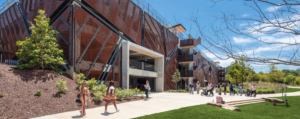One of the focal points of Epsten Group and Zoo Atlanta’s Grand New View concept was the conversion of the historic Grant Park Cyclorama building into Savanna Hall. Originally constructed in 1921, the building was formerly the home to the Battle of Atlanta painting-in-the-round commemorating the 1854 Civil War battle of the same name. The City of Atlanta closed the attraction in 2015 due to flagging attendance and Epsten Group, a zoo design firm, assisted Zoo Atlanta as it negotiated the acquisition of the building and three adjacent acres of land that became a vital habitat for its new African Savanna.
Opened in February of 2020, Savanna Hall now boasts 69,764 square feet of space. The four-story program features the zoo’s new administrative offices, two full-scale catering kitchens, and state-of-the-art events space that includes the spacious, double-height Carlos Ballroom that offers access to two levels of observation terraces overlooking the new savanna with irresistible views of the zoo’s African elephants and giraffe. The project also included the pursuit of both federal and state historic tax credits with a focused effort to highlight the remaining historic fabric of the building that still existed after a previous 1982 gut renovation and to restore and accentuate the volumetric character of several key spaces. This included restoration work on Federal-style front façade of the building and, inside the Carlos Ballroom, uncovering the remnant of the original central support column of the decagon space that had been cut and concealed in the previous renovation and installation of a new three-tiered plaster ceiling around it to approximate the ceiling condition of the original space.
With Zoo Atlanta’s conservation mission in mind, sustainability was also central to the project. Both Savanna Hall and Zambezi Elephant Center, the African elephant care quarters also designed by Epsten Group, are slated to achieve LEED Gold certification. Additionally, Epsten Group collaborated with the USGBC to develop an education course at the project’s outset using environmental life-cycle Assessment (LCA) tools to show that the re-use of the existing Cyclorama could be expected to cut the carbon emission impacts of the project by nearly 45% relative to the construction of a new facility. This once again proved the adage that the greenest building is often the one that is already standing.



